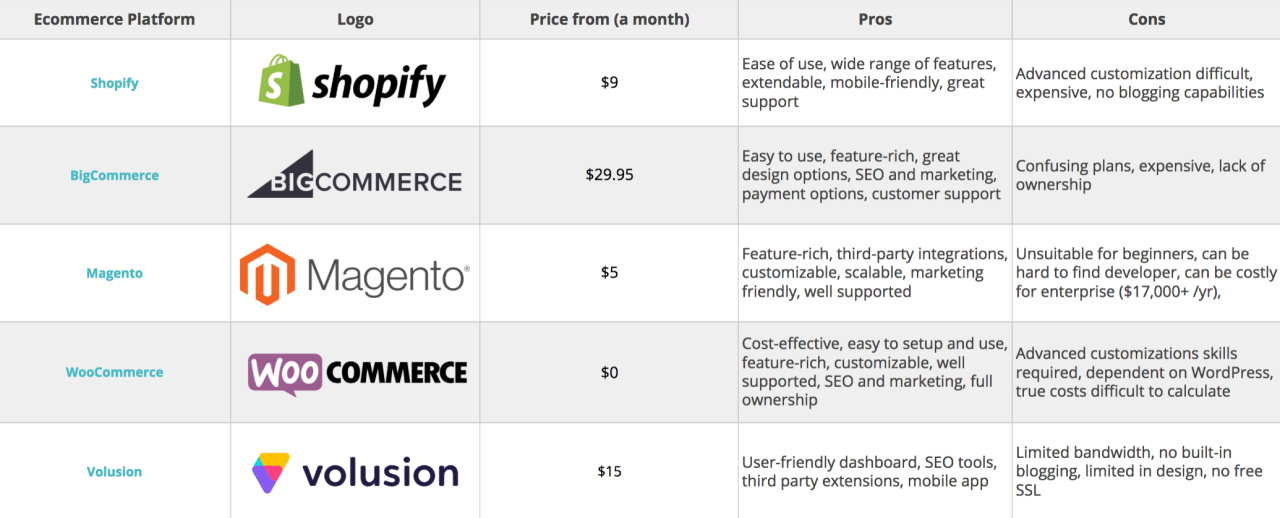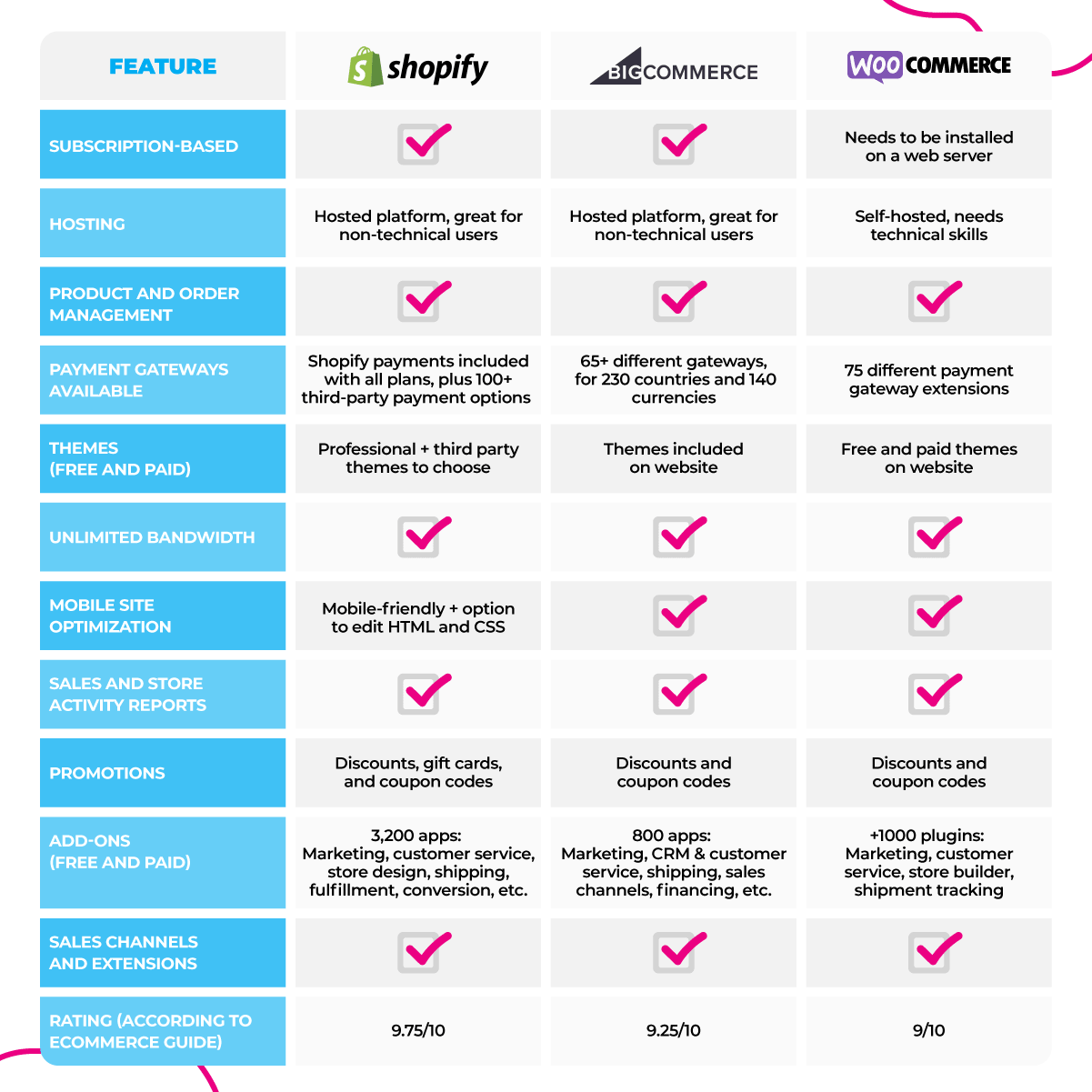E-Commerce Platforms Comparison

E-commerce Platforms Comparison brings to light the diverse landscape of e-commerce solutions, offering a comprehensive look at the various platforms available. From website design to payment gateway integration, this exploration aims to guide you towards making the best choice for your online business.
Overview of E-commerce Platforms

When it comes to choosing an e-commerce platform for your online business, there are several popular options available, each with its own set of features and functionalities tailored to different types of businesses and target audiences. Let’s take a closer look at some of the key e-commerce platforms in the market today.
Popular E-commerce Platforms
- Shopify: Shopify is a user-friendly e-commerce platform that caters to small and medium-sized businesses. It offers a wide range of customizable templates, secure payment options, and easy integration with third-party apps.
- WooCommerce: WooCommerce is a plugin for WordPress that allows users to turn their websites into e-commerce stores. It is highly customizable and offers a variety of extensions for added functionality.
- Magento: Magento is a robust e-commerce platform that is best suited for large-scale businesses with complex needs. It offers a high level of customization and scalability, making it ideal for enterprise-level businesses.
- BigCommerce: BigCommerce is a cloud-based e-commerce platform that caters to businesses of all sizes. It offers built-in features like tools, multi-channel integration, and responsive themes for mobile optimization.
Key Features and Functionalities
- Shopify: Easy to use interface, secure payment gateways, customizable templates, app integrations.
- WooCommerce: Seamless integration with WordPress, extensive plugin library, flexibility in design and functionality.
- Magento: Advanced customization options, scalability for large businesses, robust built-in features.
- BigCommerce: -friendly features, multi-channel selling capabilities, responsive themes for mobile optimization.
Target Audience
- Shopify: Ideal for small to medium-sized businesses looking for a user-friendly platform with quick setup and easy management.
- WooCommerce: Suited for WordPress users who want to add e-commerce functionality to their existing websites with flexibility and customization options.
- Magento: Best for large businesses that require advanced customization, scalability, and a high level of control over their e-commerce operations.
- BigCommerce: Suitable for businesses of all sizes looking for a cloud-based solution with built-in features and multi-channel selling capabilities.
Pricing Models
- Shopify: Offers tiered pricing plans starting from $29 per month, with additional transaction fees for using external payment gateways.
- WooCommerce: The plugin itself is free, but users will need to pay for hosting, domain, and any premium extensions they may require.
- Magento: Magento Open Source is free to use, but Magento Commerce (formerly Enterprise) is a paid version with pricing based on business needs.
- BigCommerce: Pricing starts at $29.95 per month, with higher-tier plans offering more advanced features and capabilities.
Website Design and Customization
When it comes to e-commerce platforms, website design and customization play a crucial role in attracting customers and enhancing user experience. Let’s delve into the design options, customization ease, and mobile responsiveness across different platforms.
Design Options Available, E-commerce Platforms Comparison
- Shopify: Shopify offers a wide range of professionally designed themes that can be easily customized to fit your brand. Users can also access the HTML and CSS for further customization.
- WooCommerce: WooCommerce provides a variety of themes and customization options through its integration with WordPress. Users can choose from free and premium themes to create a unique look for their online store.
- BigCommerce: BigCommerce offers a selection of responsive themes that are designed to optimize the user experience across devices. Users can also make use of the Stencil framework for advanced customization.
Customization Ease
- Shopify: Shopify’s drag-and-drop interface makes it easy for users to customize their online store without any coding knowledge. Additionally, the platform allows for advanced customization through editing the code.
- WooCommerce: WooCommerce’s integration with WordPress provides users with a high level of customization through themes and plugins. Users can modify the design and functionality of their store to suit their needs.
- BigCommerce: BigCommerce offers a user-friendly design editor that allows for easy customization of the online store. Users can adjust colors, fonts, and layouts with ease.
Importance of Mobile Responsiveness
Having a mobile-responsive design is crucial in today’s e-commerce landscape, as more and more consumers are shopping on their mobile devices. A responsive design ensures that your online store looks and functions well on smartphones and tablets, providing a seamless shopping experience for customers.
Well-Designed E-commerce Websites
Some examples of well-designed e-commerce websites across different platforms include:
1. Allbirds – Built on Shopify, Allbirds’ website features a clean and minimalist design that highlights their eco-friendly products.
2. MVMT – Powered by WooCommerce, MVMT’s website showcases sleek and stylish watches with a modern and visually appealing design.
3. KITH – Utilizing BigCommerce, KITH’s website combines bold visuals with easy navigation, creating an engaging shopping experience for customers.
Payment Gateway Integration: E-commerce Platforms Comparison
Integrating payment gateways is a crucial step in setting up an e-commerce platform. It allows customers to securely make payments for their purchases online. Let’s delve into the process, transaction fees, security measures, and tips for selecting the best payment gateway.
Process of Integrating Payment Gateways
Integrating a payment gateway involves setting up an account with a chosen provider, obtaining API keys, and configuring the gateway within your e-commerce platform. This allows seamless processing of transactions and ensures a smooth checkout experience for customers.
Comparison of Transaction Fees
- PayPal: 2.9% + $0.30 per transaction
- Stripe: 2.9% + $0.30 per transaction
- Square: 2.6% + $0.10 per transaction
- Authorize.Net: 2.9% + $0.30 per transaction
Security Measures for Payment Processing
- Encryption: Secure Socket Layer (SSL) encryption to protect sensitive data.
- PCI Compliance: Platforms adhere to Payment Card Industry Data Security Standards.
- Tokenization: Replaces sensitive data with a unique identifier to enhance security.
- Two-Factor Authentication: Additional layer of security for transactions.
Tips for Selecting the Best Payment Gateway
- Consider transaction fees and processing rates based on your sales volume.
- Evaluate the ease of integration with your e-commerce platform.
- Check for compatibility with multiple payment methods and currencies.
- Review the level of customer support provided by the payment gateway.
Inventory Management and Shipping

Inventory management and shipping are crucial aspects of running a successful e-commerce business. Let’s explore how various e-commerce platforms handle these tasks efficiently.
Inventory Management Tools
When it comes to inventory management, different e-commerce platforms offer a range of tools to help businesses keep track of their stock levels. Some platforms provide features like real-time inventory updates, low stock notifications, and automated reordering. Others may offer advanced inventory forecasting and reporting capabilities to help businesses make informed decisions about their stock.
Automation Options for Shipping and Fulfillment
Automation in shipping and fulfillment is essential for streamlining the order processing and delivery process. E-commerce platforms may integrate with shipping carriers to automatically generate shipping labels, track packages, and provide customers with real-time shipping updates. Some platforms also offer batch shipping options for processing multiple orders at once, saving time and reducing errors.
Managing Multiple Warehouses
For businesses with multiple warehouses, e-commerce platforms provide tools to manage inventory across different locations efficiently. These platforms allow businesses to track stock levels at each warehouse, fulfill orders from the nearest location to the customer, and optimize shipping costs by splitting orders between warehouses. Centralized inventory management is essential for ensuring smooth operations and timely order fulfillment.
Handling Backorders and Out-of-Stock Items
E-commerce platforms handle backorders and out-of-stock items differently, but most offer features to help businesses manage these situations effectively. Some platforms allow businesses to set up backorder notifications for customers, automatically update product availability once stock is replenished, or offer alternative products to customers when items are out of stock. Efficient management of backorders and out-of-stock items is crucial for maintaining customer satisfaction and minimizing revenue loss.
FAQ Summary
Which e-commerce platform is best for a small business?
Platforms like Shopify or WooCommerce are popular choices for small businesses due to their user-friendly interfaces and affordable pricing.
How do I choose the right payment gateway for my e-commerce store?
Consider factors like transaction fees, security measures, and compatibility with your e-commerce platform when selecting a payment gateway.
Are there e-commerce platforms that specialize in specific industries?
Yes, platforms like BigCommerce cater to specific industries such as fashion or electronics, offering tailored features for those markets.